-
CDCM9102 Low-Noise Two-Channel 100-MHz Clock Generator
- 1 Features
- 2 Applications
- 3 Description
- 4 Revision History
- 5 Device Comparison Table
- 6 Pin Configuration and Functions
- 7 Specifications
- 8 Parameter Measurement Information
- 9 Detailed Description
- 10Application and Implementation
- 11Power Supply Recommendations
- 12Layout
- 13Device and Documentation Support
- 14Mechanical, Packaging, and Orderable Information
- IMPORTANT NOTICE
Package Options
Mechanical Data (Package|Pins)
- RHB|32
Thermal pad, mechanical data (Package|Pins)
- RHB|32
Orderable Information
CDCM9102 Low-Noise Two-Channel 100-MHz Clock Generator
1 Features
- Integrated Low-Noise Clock Generator Including PLL, VCO, and Loop Filter
- Two Low-Noise 100-MHz Clocks (LVPECL, LVDS, or pair of LVCMOS)
- Support for HCSL Signaling Levels
(AC-Coupled) - Typical Period Jitter: 21 ps pk-pk
- Typical Random Jitter: 510 fs RMS
- Output Type Set by Pins
- Support for HCSL Signaling Levels
- Bonus Single-Ended 25-MHz Output
- Integrated Crystal Oscillator Input Accepts
25-MHz Crystal - Output Enable Pin Shuts Off Device and Outputs
- 5-mm × 5-mm 32-Pin VQFN Package
- ESD Protection Exceeds 2000 V HBM, 500 V CDM
- Industrial Temperature Range (–40°C to 85°C)
- 3.3-V Power Supply
2 Applications
- Reference Clock Generation for PCI Express
Gen 1, Gen 2, and Gen 3 - General-Purpose Clocking
3 Description
The CDCM9102 is a low-jitter clock generator designed to provide reference clocks for communications standards such as PCI Express™. The device supports up to PCIE gen3 and is easy to configure and use. The CDCM9102 provides two 100-MHz differential clock ports. The output types supported for these ports include LVPECL, LVDS, or a pair of LVCMOS buffers. HCSL signaling is supported using an AC-coupled network. The user configures the output buffer type desired by strapping device pins. Additionally, a single-ended 25-MHz clock output port is provided. Uses for this port include general-purpose clocking, clocking Ethernet PHYs, or providing a reference clock for additional clock generators. All clocks generated are derived from a single external 25-MHz crystal.
Device Information(1)
| PART NUMBER | PACKAGE | BODY SIZE (NOM) |
|---|---|---|
| CDCM9102 | VQFN (32) | 5.00 mm × 5.00 mm |
- For all available packages, see the orderable addendum at the end of the data sheet.
Simplified Schematic

4 Revision History
Changes from * Revision (February 2012) to A Revision
- Added ESD Ratings table, Feature Description section, Device Functional Modes, Application and Implementation section, Power Supply Recommendations section, Layout section, Device and Documentation Support section, and Mechanical, Packaging, and Orderable Information sectionGo
- Added text to Description: The device supports up to PCIE gen3 and isGo
- Changed part number to 1134 25M0000000Go
- Changed part number to FP2500002Go
- Added text and Figure 16 to PCI Express ApplicationsGo
5 Device Comparison Table
| PACKAGED DEVICES | FEATURES | TA |
|---|---|---|
| CDCM9102RHBT | 32-pin VQFN (RHB) package, small tape and reel | –40°C to 85°C |
| CDCM9102RHBR | 32-pin VQFN (RHB) package, tape and reel |
6 Pin Configuration and Functions
Pin Functions
| PIN | TYPE(1) | DESCRIPTION | |
|---|---|---|---|
| NAME | NO. | ||
| POWER SUPPLIES | |||
| GND | Thermal pad, 14, 22 | G | Power supply ground and thermal relief |
| REGCAP1 | 19 | P | Capacitor for internal regulator, connect 10-μF Y5V capacitor to GND |
| REGCAP2 | 17 | P | Capacitor for internal regulator, connect 10-μF Y5V capacitor to GND |
| VDD1 | 4 | P | Power Supply, OUT0 clock port |
| VDD2 | 1 | P | Power Supply, OUT1 clock port |
| VDD3 | 9 | P | Power supply, low-noise clock generator |
| VDD4 | 16 | P | Power supply, low-noise clock generator |
| VDD5 | 18 | P | Power supply, low-noise clock generator |
| VDD6 | 20 | P | Power supply, crystal oscillator input |
| DEVICE CONFIGURATION AND CONTROL | |||
| NC | 8, 13, 15, 24–32 | — | No connection permitted |
| OE | 7 | O | Output enable/shutdown control input (see Table 2) |
| OS1 | 10 | O | Output format select control inputs (see Table 3) |
| OS0 | 11 | O | Output format select control inputs (see Table 3) |
| RESET | 12 | I | Device reset input (active-low) (see Table 4)(2) |
| CRYSTAL OSCILLATOR | |||
| XIN | 21 | I | Parallel resonant crystal input (25 MHz) |
| DEVICE OUTPUTS | |||
| OSCOUT | 23 | O | Oscillator output port (25 MHz) |
| OUT0N | 5 | O | Output 0 – negative terminal (100 MHz) |
| OUT0P | 6 | O | Output 0 – positive terminal (100 MHz) |
| OUT1N | 2 | O | Output 1 – negative terminal (100 MHz) |
| OUT1P | 3 | O | Output 1 – positive terminal (100 MHz) |
7 Specifications
7.1 Absolute Maximum Ratings
over operating free-air temperature range (unless otherwise noted)(1)| MIN | MAX | UNIT | ||
|---|---|---|---|---|
| IIN | Input current | 20 | mA | |
| IOUT | Output current | 50 | mA | |
| VDDx | Supply voltage(2) | –0.5 | 4.6 | V |
| VIN | Input voltage(3) | –0.5 | VDDx + 0.5 | V |
| VOUT | Output voltage(3) | –0.5 | VDDx + 0.5 | V |
| TA | Operating temperature | 85 | °C | |
| Tstg | Storage temperature | –65 | 150 | °C |
7.2 ESD Ratings
| VALUE | UNIT | |||
|---|---|---|---|---|
| V(ESD) | Electrostatic discharge | Human-body model (HBM), per ANSI/ESDA/JEDEC JS-001(1) | ±2000 | V |
| Charged-device model (CDM), per JEDEC specification JESD22-C101(2) | ±500 | |||
7.3 Recommended Operating Conditions
| MIN | NOM | MAX | UNIT | ||
|---|---|---|---|---|---|
| VDDX | DC power-supply voltage | 3 | 3.3 | 3.6 | V |
| TA | Ambient temperature | –40 | 85 | °C | |
7.4 Thermal Information
| THERMAL METRIC(1)(2) | CDCM9102 | UNIT | |
|---|---|---|---|
| RHB (VQFN) | |||
| 32 PINS | |||
| RθJA | Junction-to-ambient thermal resistance | 33.1 | °C/W |
| RθJC(top) | Junction-to-case (top) thermal resistance | 25.7 | °C/W |
| RθJB | Junction-to-board thermal resistance | 0.3 | °C/W |
| ψJT | Junction-to-top characterization parameter | 7.1 | °C/W |
| ψJB | Junction-to-board characterization parameter | 2 | °C/W |
| RθJC(bot) | Junction-to-case (bottom) thermal resistance | 6.12 | °C/W |
7.5 Electrical Characteristics
over operating free-air temperature range (unless otherwise noted)| PARAMETER | TEST CONDITIONS | MIN | TYP | MAX | UNIT | |
|---|---|---|---|---|---|---|
| LVCMOS INPUTS(1) | ||||||
| VIH | Input high voltage | 0.6 × VDD | V | |||
| VIL | Input low voltage | 0.4 × VDD | V | |||
| IIH | Input high current | VDD = 3.6 V, VIL = 0 V | 200 | µA | ||
| IIL | Input low current | VDD = 3 V, VIH = 3.6 V | –200 | µA | ||
| CIN | Input capacitance | 8 | 10 | pF | ||
| RPU | Input pullup resistor | 150 | kΩ | |||
| CRYSTAL CHARACTERISTICS (XIN)(2) | ||||||
| fXTAL | Crystal input frequency | Fundamental mode | 25 | MHz | ||
| ESR | Effective series resistance of crystal | 50 | Ω | |||
| CIN | On-chip load capacitance | 8 | 10 | pF | ||
| XTALDL | Maximum drive level - XTAL | 0.1 | 1 | mW | ||
| CSHUNT | Maximum shunt capacitance | 7 | pF | |||
| CLOCK OUTPUT BUFFER (OUTPUT MODE = LVPECL)(3) | ||||||
| VOH | Output high voltage | VDD – 1.18 | VDD – 0.73 | V | ||
| VOL | Output low voltage | VDD – 2 | VDD – 1.55 | V | ||
| |VOD| | Differential output voltage | 0.6 | 1.23 | V | ||
| tR and tF | Output rise and fall time | 20% to 80% | 175 | ps | ||
| ODC | Output duty cycle | 45% | 55% | |||
| tSKEW | Skew between outputs | 20 | ps | |||
| CLOCK OUTPUT BUFFER (OUTPUT MODE = LVDS)(4) | ||||||
| |VOD| | Differential output voltage | 0.247 | 0.454 | V | ||
| ΔVOD | VOD magnitude change | 50 | mV | |||
| VOS | Common-mode voltage | 1.125 | 1.375 | V | ||
| ΔVOS | VOS magnitude change | 50 | mV | |||
| tR and tF | Output rise and fall time | 20% to 80% | 255 | ps | ||
| ODC | Output duty cycle | 45% | 55% | |||
| tSKEW | Skew between outputs | 30 | ps | |||
| CLOCK OUTPUT BUFFER (OUTPUT MODE = LVCMOS)(5) | ||||||
| VOH | Output high voltage | VCC = 3 V to 3.6 V, IOH = –100 µA | VDD – 0.5 | V | ||
| VOL | Output low voltage | VCC = 3 V to 3.6 V, IOH = 100 µA | 0.3 | V | ||
| tSLEW | Output rise/fall slew rate | 20% to 80% | 2.4 | V/ns | ||
| ODC | Output duty cycle | 45% | 55% | |||
| tSKEW | Skew between outputs | 50 | ps | |||
7.6 Timing Requirements
fOUT = 100 MHz, VDD = 3.3 V, TA = 25°C, and jitter integration bandwidth between 10 kHz and 20 MHz (unless otherwise noted)| MIN | TYP | MAX | UNIT | |
|---|---|---|---|---|
| LVCMOS OUTPUT MODE | ||||
| Random jitter | 507 | fs RMS | ||
| Period jitter | 24.5 | ps pk-pk | ||
| LVPECL OUTPUT MODE | ||||
| Random jitter | 510 | fs RMS | ||
| Period jitter | 20.7 | ps pk-pk | ||
| LVDS OUTPUT MODE | ||||
| Random jitter | 533 | fs RMS | ||
| Period jitter | 26.5 | ps pk-pk | ||
7.7 Typical Characteristics
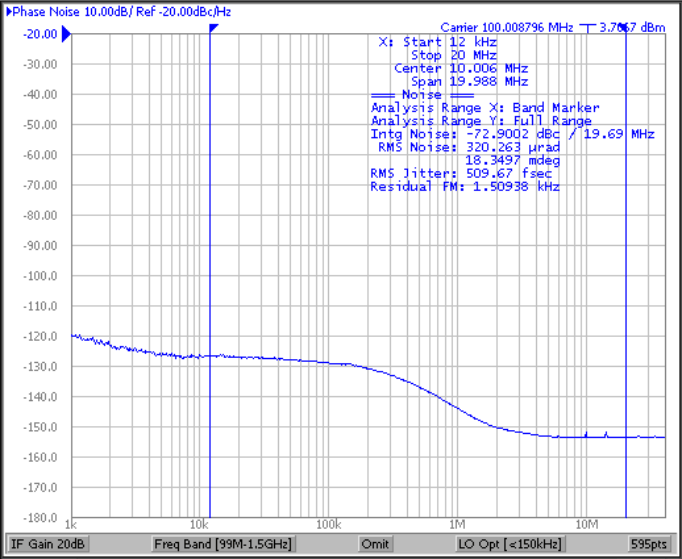 Figure 1. CDCM9102 Typical Phase Noise Performance (LVPECL Mode)
Figure 1. CDCM9102 Typical Phase Noise Performance (LVPECL Mode)
8 Parameter Measurement Information
8.1 Test Configurations
 Figure 2. LVCMOS Output Test Load
Figure 2. LVCMOS Output Test Load
 Figure 3. LVCMOS AC Configuration for Device Test
Figure 3. LVCMOS AC Configuration for Device Test
 Figure 4. LVPECL DC Configuration for Device Test
Figure 4. LVPECL DC Configuration for Device Test
 Figure 5. LVPECL AC Configuration for Device Test
Figure 5. LVPECL AC Configuration for Device Test
 Figure 6. LVDS DC Configuration for Device Test
Figure 6. LVDS DC Configuration for Device Test
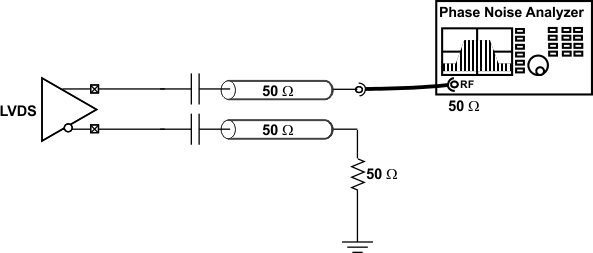 Figure 7. LVDS AC Configuration for Device Test
Figure 7. LVDS AC Configuration for Device Test
9 Detailed Description
9.1 Overview
The CDCM9102 is a high-performance PLL that generates 2 copies of commonly-used reference clocks with less than 1-ps RMS jitter from a low-cost crystal.
9.2 Functional Block Diagrams
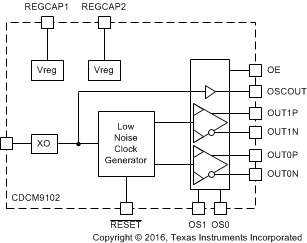
9.3 Feature Description
The CDCM9102 includes an on-chip PLL with an on-chip VCO. The PLL blocks consist of a crystal input interface, a phase frequency detector (PFD), a charge pump, an on-chip loop filter, and prescaler and feedback dividers. Completing the CDCM9102 device are the output divider and universal output buffer. The PLL and output divider are pre-programmed to generate 2 copies of 100 MHz in LVCMOS, LVPECL or LVDS format.
The PLL is powered by on-chip, low-dropout (LDO) linear voltage regulators. The regulated supply network is partitioned such that the sensitive analog supplies are powered from separate LDOs rather than the digital supplies which use a separate LDO regulator. These LDOs provide isolation for the PLL from any noise in the external power-supply rail. The REG_CAP1 and REG_CAP2 pins should each be connected to ground by 10-μF capacitors to ensure stability.
9.4 Device Functional Modes
9.4.1 Crystal Input (XIN) Interface
The CDCM9102 implements a Colpitts oscillator; therefore, one side of the crystal connects to the XIN pin and the other crystal terminal connects to ground. The device requires the use of a fundamental-mode crystal, and the oscillator operates in parallel resonance mode. The correct load capacitance is necessary to ensure that the circuit oscillates properly. The load capacitance comprises all capacitances in the oscillator feedback loop (the capacitances seen between the terminals of the crystal in the circuit). It is important to account for all sources of capacitance when calculating the correct value for the external discrete load capacitance shown in Figure 8.
 Figure 8. Configuration of Circuit for CDCM9102 XIN Oscillator
Figure 8. Configuration of Circuit for CDCM9102 XIN Oscillator
The CDCM9102 has been characterized with 10-pF parallel-resonant crystals. The input stage of the crystal oscillator in the CDCM9102 is designed to oscillate at the correct frequency for all parallel-resonant crystals with low-pull capability and rated with a load capacitance that is equal to the sum of the on-chip load capacitance at the XIN pin (CIN = 10 pF maximum), crystal stray capacitance, and board parasitic capacitance between the crystal and XIN pin. To minimize stray and parasitic capacitances, minimize the trace distance routed from the crystal to the XIN pin and avoid other active traces and active circuitry in the area of the crystal oscillator circuit. Table 1 lists crystal types that have been evaluated with the CDCM9102.
Table 1. CDCM9102 Crystal Recommendations
| MANUFACTURER | PART NUMBER |
|---|---|
| Vectron | VXC1-1134 25M0000000 |
| Fox | 218-3 |
| Saronix | FP2500002 |
A mismatch of the load capacitance results in a frequency error according to Equation 1.

where
- Δƒ is the frequency error required by the application.
- f is the fundamental frequency of the crystal.
- CS is the motional capacitance of the crystal. This is a parameter in the data sheet of the crystal.
- C0 is the shunt capacitance of the crystal. This is a parameter in the data sheet of the crystal.
- CLr is the rated load capacitance of the crystal. This is a parameter in the data sheet of the crystal.
- CLa is the actual load capacitance implemented on the PCB (CIN + stray capacitance + parasitic capacitance + CL).
The difference between the rated load capacitance (from the crystal datasheet) and the actual load capacitance (CLa = CIN + CL + CSTRAY + CPARASITIC) should be minimized. A crystal with a low pullability rating (low CS) is ideal.
Design Example:
Desired frequency tolerance Δf ≤ ±80 ppm
Crystal Vendor Parameters:
Intrinsic Frequency Tolerance = ±30 ppm
C0 = 7 pF (shunt capacitance)
CS = 10 fF (motional capacitance)
CLr = 12 pF (load capacitance)
Substituting these parameters into Equation 1 yields a maximum value of CLa = 17 pF to achieve the desired Δf (±50 ppm). Recall that CLa = CIN + CL + CSTRAY + CPARASITIC = 8 pF + (CL + CSTRAY + CPARASITIC). Ideally, the load presented to this crystal should be 12 pF; therefore, the sum of (CL + CSTRAY + CPARASITIC) must be less than 9 pF. Stray and parasitic capacitance must be controlled. This is because the Colpitts oscillator is particularly sensitive to capacitance in parallel with the crystal; therefore, good layout practice is essential. TI recommends that the designer extract the stray and parasitic capacitance from the printed-circuit board design tool and adjust CL accordingly to achieve CLr = CLa. In common scenarios, the external load capacitor is often unnecessary; however, TI recommends that pads be implemented to accommodate an external load capacitor so that the ppm error can be minimized.
9.4.2 Interfacing between LVPECL and HCSL (PCI Express)
Certain PCI Express applications require HCSL signaling. Because the common-mode voltage for LVPECL and HCSL are different, applications requiring HCSL signaling must use AC-coupling as shown in Figure 9. The
150-Ω resistors ensure proper biasing of the CDCM9102 LVPECL output stage. The 471-Ω and 56-Ω resistor network biases the HCSL receiver input stage.
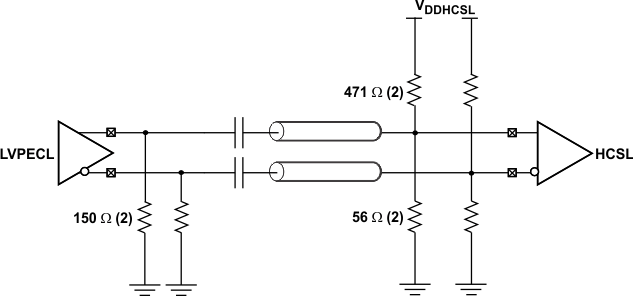
9.5 Programming
Table 2 and Table 3 list the pin controls and pin configurations of the CDCM9102 output. Table 4 lists the device reset.
9.5.1 Device Configuration
Table 2. CDCM9102 Pin Control of Output Enable
| OE (Pin 7) | MODE | DEVICE CORE | OUTPUT |
|---|---|---|---|
| 0 | Power down | Power down | Hi-Z |
| 1 | Normal | Active | Active |
Table 3. CDCM9102 Pin Configuration of Output Type
| CONTROL PINS | OUTPUT MODE | |
|---|---|---|
| OS1 (Pin 10) | OS0 (Pin 11) | |
| 0 | 0 | LVCMOS, OSCOUT = OFF |
| 0 | 1 | LVDS, OSCOUT = OFF |
| 1 | 0 | LVPECL, OSCOUT = OFF |
| 1 | 1 | LVPECL, OSCOUT = ON |
Table 4. CDCM9102 Device Reset
| RESET (Pin 12) | OPERATING MODE | DEVICE OUTPUTS |
|---|---|---|
| 0 | Device reset | Hi-Z |
| 0 → 1 | Clock generator calibration | Hi-Z |
| 1 | Normal | Active |
10 Application and Implementation
NOTE
Information in the following applications sections is not part of the TI component specification, and TI does not warrant its accuracy or completeness. TI’s customers are responsible for determining suitability of components for their purposes. Customers should validate and test their design implementation to confirm system functionality.
10.1 Application Information
10.1.1 Start-Up Time Estimation
The CDCM9102 contains a low-noise clock generator that calibrates to an optimal operating point at device power up. To ensure proper device operation, the oscillator must be stable before the low-noise clock generator calibration procedure. Quartz-based oscillators can take up to 2 ms to stabilize; therefore, TI recommends that the application ensure that the RESET pin is de-asserted at least 5 ms after the power supply has finished ramping. This can be accomplished by controlling the RESET pin directly, or by applying a 47-nF capacitor to ground on the RESET pin (this provides a delay because the RESET pin includes a 150-kΩ pullup resistor.
The CDCM9102 start-up time can be estimated based on parameters defined in Table 5 and graphically shown in Figure 10.
Table 5. CDCM9102 Start-Up Time Dependencies
| PARAMETER | DEFINITION | DESCRIPTION | FORMULA OR METHOD OF DETERMINATION |
|---|---|---|---|
| tREF | Reference clock period | The reciprocal of the applied reference frequency in seconds |  |
| tpul | Power-up time (low limit) | Power-supply rise time to low limit of power-on-reset trip point | Time required for power supply to ramp to 2.27 V |
| tpuh | Power-up time (high limit) | Power supply rise time to high limit of power-on-reset trip point | Time required for power supply to ramp to 2.64 V |
| trsu | Reference start-up time | After POR releases, the Colpitts oscillator is enabled. This start-up time is required for the oscillator to generate the requisite signal levels for the delay block to be clocked by the reference input. | 500 μs best case and 800 μs worst case (for a crystal input) |
| tdelay | Delay time | Internal delay time generated from the reference clock. This delay provides time for the reference oscillator to stabilize. | tdelay = 16,384 × tREF = 655 µs |
| tVCO_CAL | VCO calibration time | VCO calibration time generated from the reference clock. This process selects the operating point for the VCO based on the PLL settings. | tVCO_CAL = 550 × tREF = 22 µs |
| tPLL_LOCK | PLL lock time | Time requried for PLL to lock within ±10 ppm of fREF | The PLL settles in 12.5 μs |
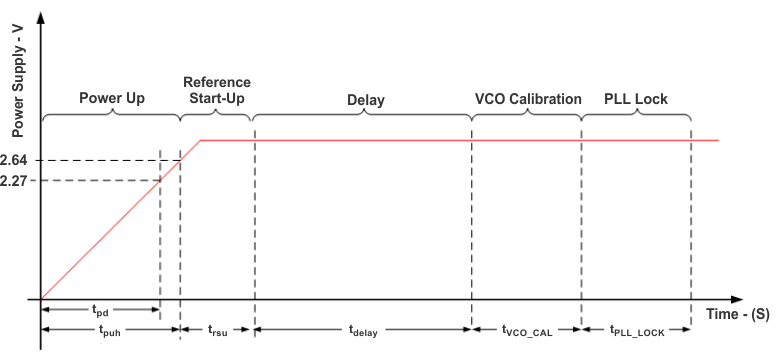 Figure 10. CDCM9102 Start-Up Time Dependencies
Figure 10. CDCM9102 Start-Up Time Dependencies
The CDCM9102 start-up time limits, tMAX and tMIN, can now be calculated with Equation 2 and Equation 3.
10.1.2 Output Termination
The CDCM9102 is a 3.3-V clock driver which has the following options for the output type: LVPECL, LVDS, and LVCMOS.
10.1.3 LVPECL Termination
The CDCM9102 is an open emitter for LVPECL outputs. Therefore, proper biasing and termination is required to ensure correct operation of the device and to optimize signal integrity. The proper termination for LVPECL is 50 Ω to (Vcc-2) V but this DC voltage is not readily available on a board. Thus a Thevenin’s equivalent circuit is worked out for the LVPECL termination in both direct-coupled (DC) and AC-coupled cases, as shown in Figure 11 and Figure 12. TI recommends placing all resistive components close to either the driver end or the receiver end. If the supply voltages of the driver and receiver are different, AC coupling is required.
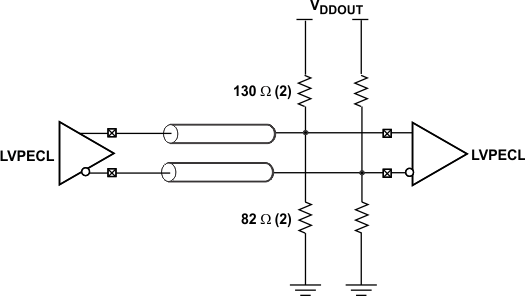 Figure 11. LVPECL Output Termination (DC-Coupled)
Figure 11. LVPECL Output Termination (DC-Coupled)
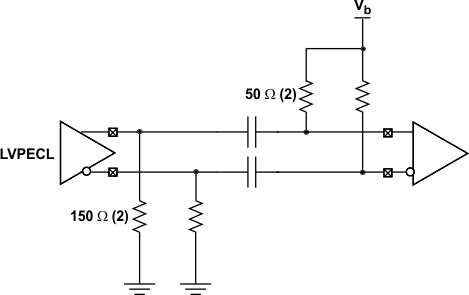 Figure 12. LVPECL Output Termination (AC-Coupled)
Figure 12. LVPECL Output Termination (AC-Coupled)
10.1.4 LVDS Termination
The proper LVDS termination for signal integrity over two 50-Ω lines is 100 Ω between the outputs on the receiver end. Either a direct-coupled (dc) termination or ac-coupled termination can be used for LVDS outputs, as shown in Figure 13 and Figure 14. TI recommends placing all resistive components close to either the driver end or the receiver end. If the supply voltages of the driver and receiver are different, AC coupling is required.
 Figure 13. LVDS Output Termination (DC Coupled)
Figure 13. LVDS Output Termination (DC Coupled)
 Figure 14. LVDS Output Termination (AC Coupling)
Figure 14. LVDS Output Termination (AC Coupling)
10.1.5 LVCMOS Termination
Series termination is a common method to maintain the signal integrity for LVCMOS drivers, if connected to a receiver with a high-impedance input. For series termination, a series resistor, Rs, is placed close to the driver, as shown in Figure 15. The sum of the driver impedance and Rs should be close to the transmission-line impedance, which is usually 50 Ω. Because the LVCMOS driver in the CDCM9102 has an impedance of 30 Ω, TI recommends Rs be 22 Ω to maintain proper signal integrity.
 Figure 15. LVCMOS Output Termination
Figure 15. LVCMOS Output Termination
10.1.6 PCI Express Applications
Texas Instruments offers a complete clock solution for PCI Express applications. The CDCUN1208LP can be used to fan out reference clock generated by the CDCM9102 as shown in Figure 16.
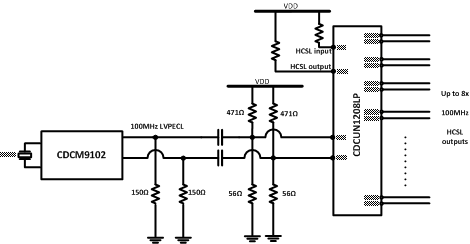 Figure 16. Clock Solution for PCIE Express Applications
Figure 16. Clock Solution for PCIE Express Applications
10.2 Typical Application
 Figure 17. CDCM9102 Typical Application Example
Figure 17. CDCM9102 Typical Application Example
10.2.1 Design Requirements
Consider a typical wired communications application, like a top-of-rack switch, which needs to clock PCI Express Gen 2 or 3 PHYs. For such asynchronous systems, the reference input can be a crystal. In such systems, the clocks are expected to be available upon power up without the need for any device-level programming. An example of clock input and output requirements is shown below:
- Clock Input:
- 25-MHz crystal
- Clock Outputs:
- 2× 100 MHz clock for PCI Express Gen 3 (8 GT/s), LVPECL
See Detailed Design Procedure for how to generate the required output frequencies for this application using the CDCM9102.
10.2.2 Detailed Design Procedure
Design of all aspects of the CDCM61004 is quite involved and software support is available to assist in part selection and phase noise simulation. This design procedure will give a quick outline of the process.
- Device Selection
- The first step is to calculate the VCO frequency given the required output frequency. The device must be able to produce the VCO frequency that can be divided down to the required output frequency.
- The WEBENCH Clock Architect Tool from TI will aid in the selection of the right device that meets the customer's output frequencies and format requirements.
- Device Configuration
- The WEBENCH Clock Architect Tool attempts to maximize the phase detector frequency, use smallest dividers, and maximizes PLL bandwidth.
10.2.2.1 Device Selection
Use the WEBENCH Clock Architect Tool. Enter the required frequencies and formats into the tool. To use this device, find a solution using the CDCM9102.
10.2.2.1.1 Calculation Using LCM
In this example, the valid VCO frequency for CDCM9102 is 1.8 GHz.
10.2.2.2 Device Configuration
For this example, when using the WEBENCH Clock Architect Tool, the reference would have been manually entered as 25 MHz according to input frequency requirements. Enter the desired output frequencies and click on Generate Solutions. Select CDCM9102 from the solution list.
From the simulation page of the WEBENCH Clock Architect Tool, it can be seen that to maximize phase detector frequencies, the N divider is set to 24 and prescaler divider is set to 3. This results in a VCO frequency of
1.8 GHz. The output divider is set to 6. At this point the design meets all input and output frequency requirements and simulate performance on the clock outputs. Figure 18 shows the typical phase noise plot of the 100 MHz LVPECL output.
10.2.3 Application Curve
 Figure 18. Typical Phase Noise Plot of 100 MHz LVPECL Output
Figure 18. Typical Phase Noise Plot of 100 MHz LVPECL Output
11 Power Supply Recommendations
TA = –40°C to 85°C, VDDx = 3.3 V, OE = 1, values represent cumulative current/power on all VDDx pins.
Table 6. Device Current Consumption
| BLOCK | CONDITION | CURRENT (mA) | DEVICE POWER (mW) | EXTERNAL RESISTOR POWER (mW) |
|---|---|---|---|---|
| Entire device, core current |
85 | 280 | ||
| Output Buffers | LVPECL | 28 | 42.4 | 50 |
| LVDS | 20 | 66 | ||
| LVCMOS | V × ƒout × (CL + 20 × 10–12) × 103 | V2 × ƒout × (CL + 20 × 10–12) × 103 |
11.1 Thermal Management
To ensure optimal performance and reliability, good thermal design practices are important when using the CDCM9102. Die temperature should be limited to a maximum of 125°C. That is, as an estimate, TA (ambient temperature) plus device power consumption times RθJA should not exceed 125°C.
The device package has an exposed pad that provides the primary heat removal path as well as an electrical grounding to the printed circuit board (PCB). To maximize the removal of heat from the package, a thermal landing pattern including multiple vias to a ground plane must be incorporated on the PCB within the footprint of the package. The exposed pad must be soldered down to ensure adequate heat conduction out of the package. A recommended land and via pattern is shown in Figure 19.
 Figure 19. Recommended PCB Layout for CDCM9102
Figure 19. Recommended PCB Layout for CDCM9102
11.2 Power Supply Filtering
PLL-based frequency synthesizers are very sensitive to noise on the power supply, which can dramatically increase the jitter of the PLL. This is especially true for analog-based PLLs. Thus, it is essential to reduce noise from the system power supply, especially when jitter/phase noise is very critical to applications. A PLL has attenuated jitter due to power supply noise at frequencies beyond the PLL bandwidth due to attenuation by the loop response.
Filter capacitors are used to eliminate the low-frequency noise from the power supply, where the bypass capacitors provide the very low-impedance path for high-frequency noise and guard the power supply system against induced fluctuations. The bypass capacitors also provide a source of instantaneous current as required by the device output stages. Therefore, bypass capacitors must have low ESR. To properly use the bypass capacitors, they must be placed very close to the power supply pins and must be laid out with short loops to minimize inductance.
Figure 20 shows a general recommendation for decoupling the power supply. The CDCXM9102 power supplies fall into one of two categories: analog supplies (VDD3, VDD4, and VDD5), and input/output supplies (VDD1, VDD2, and VDD6). Short the analog supplies together to form the analog supply node; likewise, short the input/output supplies together to form the I/O supply node. Isolate the analog node from the PCB power supply and I/O node by inserting a ferrite bead. This helps isolate the high-frequency switching noises generated by the clock drivers and I/O from the sensitive analog supply node. Choosing an appropriate ferrite bead with low dc resistance is important, as it is imperative to maintain a voltage at the power-supply pin of the CDCM9102 that is over the minimum voltage needed for its proper operation.
 Figure 20. CDCM9102 Power Supply Decoupling – Power Pin Bypass Concept
Figure 20. CDCM9102 Power Supply Decoupling – Power Pin Bypass Concept
12 Layout
12.1 Layout Guidelines
The CDCM9102 is a high-performance device; therefore, pay careful attention to device configuration and printed-circuit board layout with respect to power consumption. Observing good thermal layout practices enables the thermal pad on the backside of the 32-pin VQFN package to provide a good thermal path between the die contained within the package and the ambient air. This thermal pad also serves as the ground connection the device; therefore, a low inductance connection to the ground plane is essential.
12.2 Layout Example
Figure 21 shows a general recommendation of PCB layout with the CDCM9102 that ensures good system-level thermal reliability.
 Figure 21. Recommended PCB Layout
Figure 21. Recommended PCB Layout
13 Device and Documentation Support
13.1 Community Resources
The following links connect to TI community resources. Linked contents are provided "AS IS" by the respective contributors. They do not constitute TI specifications and do not necessarily reflect TI's views; see TI's Terms of Use.
-
TI E2E™ Online Community TI's Engineer-to-Engineer (E2E) Community. Created to foster collaboration among engineers. At e2e.ti.com, you can ask questions, share knowledge, explore ideas and help solve problems with fellow engineers.
-
Design Support TI's Design Support Quickly find helpful E2E forums along with design support tools and contact information for technical support.
13.2 Trademarks
E2E is a trademark of Texas Instruments.
PCI Express is a trademark of PCI-SIG.
All other trademarks are the property of their respective owners.
13.3 Electrostatic Discharge Caution

These devices have limited built-in ESD protection. The leads should be shorted together or the device placed in conductive foam during storage or handling to prevent electrostatic damage to the MOS gates.
13.4 Glossary
SLYZ022 — TI Glossary.
This glossary lists and explains terms, acronyms, and definitions.
14 Mechanical, Packaging, and Orderable Information
The following pages include mechanical, packaging, and orderable information. This information is the most current data available for the designated devices. This data is subject to change without notice and revision of this document. For browser-based versions of this data sheet, refer to the left-hand navigation.